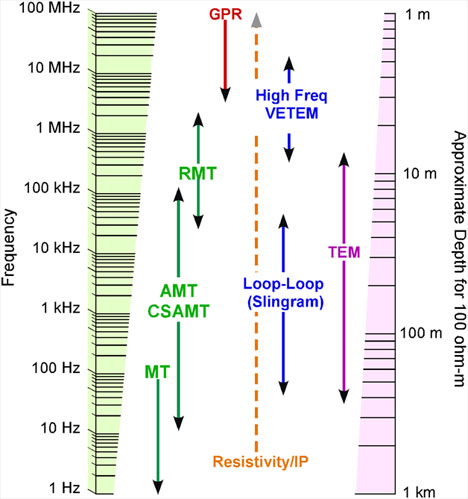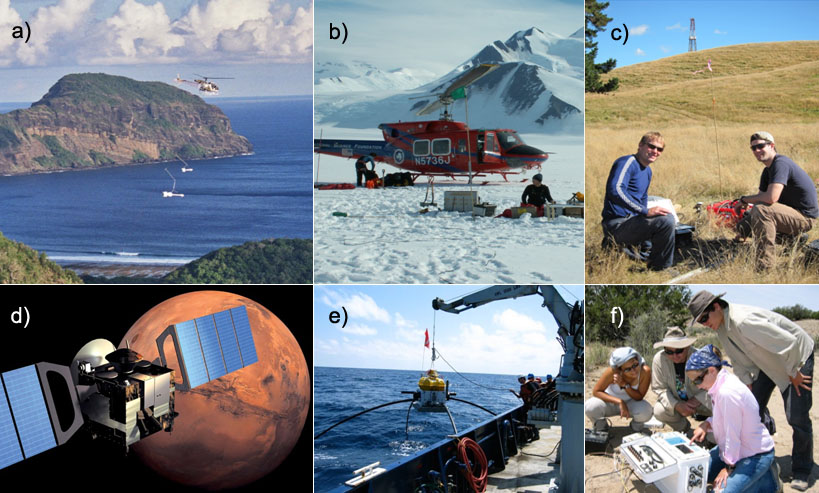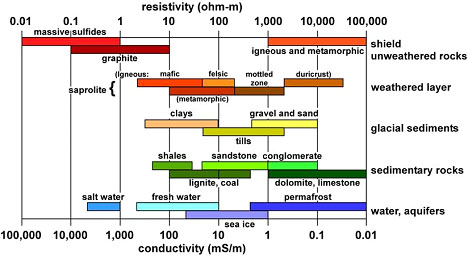0.0 Foreward
Years ago I gave a talk at San Diego State University called “What is Magnetotellurics and Who Cares?” The title was so engaging that it was featured in a gossip column in the San Diego Union Tribune citing the strange things going at the university. Magnetotellurics (MT) is one of the many electromagnetic (EM) techniques used by geophysicists to explore the Earth. Figure 0.1lists common geophysical EM techniques using frequencies from 1 Hz to 100 MHz. Included are their approximate depths of exploration assuming an Earth of 100 ohm-m. As you can see, MT has many varieties: RMT, AMT, CSAMT, and classical MT. Those who want to know “What is MT?” are encouraged to go to the Digital Analysis of Geophysical Signals and Waves (DAGSAW) website, section 5.2 (http://dagsaw.sdsu.edu/5.2.html).
 |
| Figure 0.1. Common EM geophysics methods in the 1 Hz to 100 MHz frequency range. RMT, AMT, and CSAMT are radio-, audio-, controlled source audio- magnetotellurics (MT). GPR is ground penetrating radar, VETEM is very early time EM, IP is induced polarization, and TEM is transient EM (from L. Pellerin, personal communication, 2011). |
We all should care about EM geophysics because it addresses many, critical national needs such as energy independence, strategic metals, clean and plentiful water, a healthy and safe environment, geotechnical analysis, national security, and planetary exploration. It also contributes to understanding the dynamic Earth, including volcanic and earthquake hazards. The scales of these investigations range from lithospheric plates to pore fluids (plates to pores). Figure 0.2 shows examples of EM geophysics at work.
 |
| Figure 0.2. EM Geophysics Works: a) Airborne EM mineral exploration, b) Antarctic MT ice stability study, c) New Zealand MT geothermal monitoring, d) Mars orbiting radar, e) marine EM, f) New Mexico SAGE TEM groundwater studies. |
The main focus of this website is to understand the Earth properties measured by EM methods. Figure 01 hints at this by citing 100 ohm-m. This is a numerical value of the EM property of electrical resistivity, ρ which along with the magnetic permeability, μ and electric permittivity, ε are the three physical EM Earth properties. These parameters are often simply real, scalar numbers, but they can be 3 x 3 tensors where conditions are anisotropic. They also can be complex functions of frequency. The goal of EM geophysics is the three-dimensional (x, y, z) imaging of these properties in the Earth. Theoretically, the properties are imbedded in Maxwell’s famous curl equations that connect time-varying electric and magnetic fields. Rather than launch into Maxwell’s equations using vector calculus, this website relates the three EM properties to the common electric circuit elements, namely: resistor, inductor, and capacitor. This approach is used because most university students are familiar with electric circuits from their introductory physics classes. Appendix A has an animation that graphically explains Maxwell’s curl relations.
The electrical resistivity (or it’s reciprocal, the electrical conductivity, σ) is the parameter most often measured by EM geophysicists. Figure 0.3 shows resistivity values covering 7 orders of magnitude from highly conductive (low resistivity) sulfide ores and saline water to highly resistive (low conductivity) dry, crystalline rocks. Most common geophysical properties, such as seismic velocities and density, vary by less than an order of magnitude. This contrasts with natural electrical resistivity variations of over 20 orders of magnitude, although most surficial rock resistivities are from 1-1000 ohm-m. Because of the very low resistivities of fluids and metallic minerals, EM techniques have a unique sensitivity to very low fractions (~1%) of interconnected fluids (aqueous or melt) and even lessor fractions of metallic minerals. Therefore, EM geophysical methods dominate hydrologic investigations, exploration for metallic minerals, and the renewed emphasis on geothermal energy (Figure 0.2).
 |
Figure 0.3. Typical ranges of electrical resistivity (ohm-m) or conductivity (mS/m) for selected Earth materials (Palacky, 1988). |
